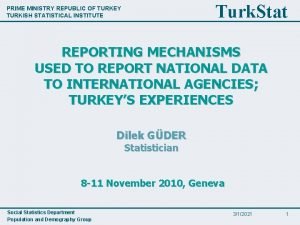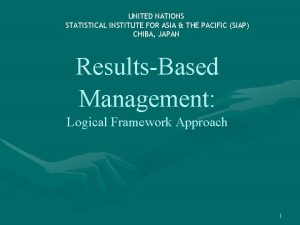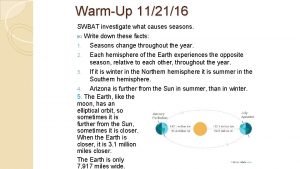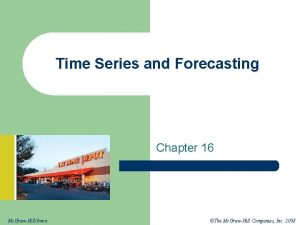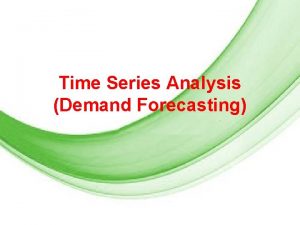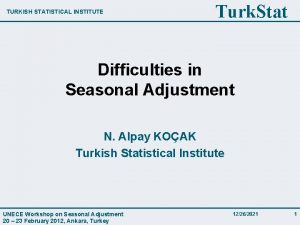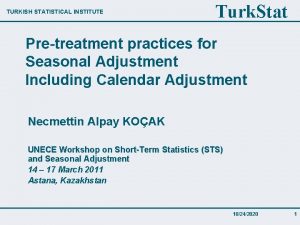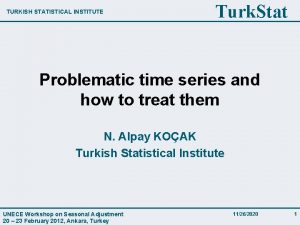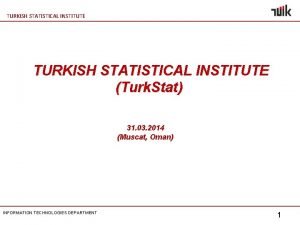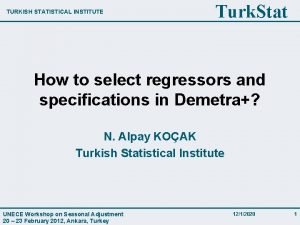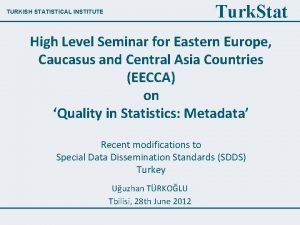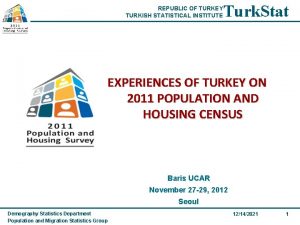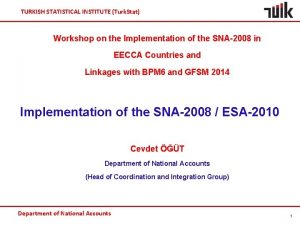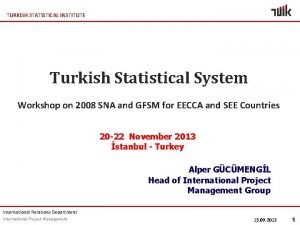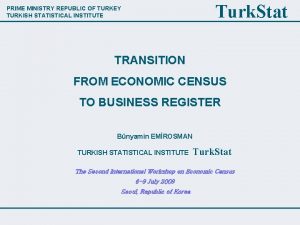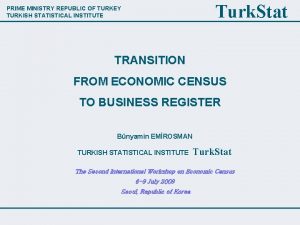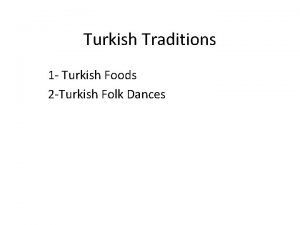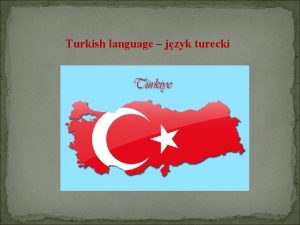TURKISH STATISTICAL INSTITUTE Turk Stat Model Selection Seasonal
















- Slides: 16

TURKISH STATISTICAL INSTITUTE Turk. Stat Model Selection, Seasonal Adjustment, Analyzing Results Necmettin Alpay KOÇAK UNECE Workshop on Short-Term Statistics (STS) and Seasonal Adjustment 14 – 17 March 2011 Astana, Kazakhstan 9/30/2020 1

TURKISH STATISTICAL INSTITUTE Turk. Stat Model Selection • Pre-treatment is the most important stage of the seasonal adjustment • X-12 -ARIMA and TRAMO&SEATS methods use very similar (nearly same) approaches to obtain the linearized (pre-treated) series. • Both method use ARIMA model for pre-treatment. • The most appropriate ARIMA model → Linearized series of top quality 9/30/2020 2

TURKISH STATISTICAL INSTITUTE Turk. Stat ARIMA Model selection • zt = ytβ+xt • Φ(B)δ(B)xt=θ(B)at • • (p, d, q)(P, D, Q)s → Structure of ARIMA (0, 1, 1)4, 12 For the model – Parsimonious – Significance of parameters – Smallest BIC or AIC For the residuals – Normality – Lack of auto-correlation – Linearity – Randomness 9/30/2020 3

Turk. Stat TURKISH STATISTICAL INSTITUTE Diagnostics • Are there really any seasonal fluctations in the series ? – Seasonality test • If, yes – Diagnostics based on residuals are the core of the analysis. • If, no – No need to seasonal adjustment.

Turk. Stat TURKISH STATISTICAL INSTITUTE Diagnostics • Seasonality test – Friedman test – Kruskall-wallis test • Residual diagnostics – Normality • Skewness • Kurtosis – Auto-correlation • First and seasonal frequencies (4 or 12) – Linearity • Auto-correlation in squared residuals – Randomness • Number of sign (+) should be equal the number of sign (-) in residuals. • Final Comment. . . We select the appropriate model according to the state of the diagnostics. i

TURKISH STATISTICAL INSTITUTE Turk. Stat Seasonal Adjustment • 2. 1 Choice of SA approach • 2. 2 Consistency between raw and SA data • 2. 3 Geographical aggregation: direct versus indirect approach • 2. 4 Sectoral aggregation: direct versus indirect approach • (Source : ESS Guidelines)

Turk. Stat Choice of seasonal adjustment method Most commonly used seasonal adjustment methods TURKISH STATISTICAL INSTITUTE • • Tramo-Seats • X 12 ARIMA • Tramo-Seats: model-based approach based on Arima decomposition techniques • X-12 -ARIMA: non parametric approach based on a set of linear filters (moving averages) • Univariate or multivariate structural time series models • (Source : ESS Guidelines)

Turk. Stat Filtering data : Difference in methods TURKISH STATISTICAL INSTITUTE • • X-12 -ARIMA use fixed filters to obtain seasonal component in the series. A 5 -term weighted moving average (3 x 3 ma) is calculated for each month of the seasonal-irregular ratios (SI) to obtain preliminary estimates of the seasonal factors • Why is this 5 -term moving average called a 3 x 3 moving average?

Turk. Stat Filtering data : Difference in methods TURKISH STATISTICAL INSTITUTE • TRAMO&SEATS use a varying filter to obtain seasonal component in the series. This variation depends on the estimated ARIMA model of the time series. • For example, if series follows an ARIMA model like (0, 1, 1), it has specific filter or it follows (1, 1, 1), it has also specific filter. Then, estimated parameters affect the filters. • Wiener-Kolmogorov filters are used in Tramo&Seats. It fed with auto-covariance generating functions of the series. (more complicated than X-12 -ARIMA) • But, it is easily interpreted since it has statistical properties.

Turk. Stat Consistency between raw and SA data TURKISH STATISTICAL INSTITUTE • We do not expect that the annual totals of raw and SA data are not equal. • Since calendar effect exists (working days in a year) • It is possible to force the sum (or average) of seasonally adjusted data over each year to equal the sum (or average) of the raw data, but from a theoretical point of view, there is no justification for this. – Do not impose the equality over the year to the raw and the seasonally adjusted or the calendar adjusted data (ESS Guidelines)

TURKISH STATISTICAL INSTITUTE Turk. Stat Direct and indirect adjustment • Direct seasonal adjustment is performed if all time series, including aggregates, are seasonally adjusted on an individual basis. Indirect seasonal adjustment is performed if the seasonally adjusted estimate for a time series is derived by combining the estimates for two or more directly adjusted series. The direct and indirect issue is relevant in different cases, e. g. within a system of time series estimates at a sector level, or aggregation of similar time series estimates from different geographical entities. Mining and EU-27 Quarrying Aggregate Industrial Production Index Manufacturing Germany Electricity, Water, Natural Gas and etc. France Spain. . . Romania

TURKISH STATISTICAL INSTITUTE Turk. Stat Analyzing result • Use a detailed set of graphical, descriptive, non-parametric and parametric criteria to validate the seasonal adjustment. Particular attention must be paid to the following suitable characteristics of seasonal adjustment series: – – – existence of seasonality absence of residual calendar effects absence of an over-adjustment of seasonal and calendar effects absence of significant and positive autocorrelation for seasonal lags in the irregular component – stability of the seasonal component • In addition, the appropriateness of the identified model used in the complete adjustment procedure should be checked using standard diagnostics and some additional considerations. An important consideration is that the number of outliers should be relatively small, and not unduly concentrated around the same period of the year.

Turk. Stat TURKISH STATISTICAL INSTITUTE Analyzing results Time Series Deterministic Components Outliers Calendar Effects Stochastic Components Trend-Cycle Seasonal Final Trend-Cycle Final Seasonal Irregular Additive Outlier (AO) Transitory Change (TC) Level Shift (LS) Seasonally Adjusted Series Final Irregular

TURKISH STATISTICAL INSTITUTE Turk. Stat Revisions to seasonal adjustment • Forward factors / current adjustment: annual analysis to determine seasonal and trading day factors – Preferable for time series with constant seasonal factor or large irregular factor causing revision • Concurrent adjustment: uses the data available at each reference period to re-estimate seasonal and trading day factors

TURKISH STATISTICAL INSTITUTE Turk. Stat Revisions to seasonal adjustment • Forecast seasonal factors for the next year (current adjustment) • Forecast seasonal factors for the next year, but update the forecast with new observations while the model and parameters stay the same • Forecast seasonal factors for the next year, but reestimate parameters of the model with new observations while the model stays the same (partial concurrent adjustment) • Compute the optimal forecast at every period and revise the model and parameters (concurrent adjustment) Sources: Eurostat working paper on Seasonal Adjustment Policy, ESS Guidelines on Seasonal Adjustment

TURKISH STATISTICAL INSTITUTE Turk. Stat Evaluation of revision alternatives • The use of fixed seasonal factors can lead to biased results when unexpected events occur • Re-estimation in every calculation increases accuracy but also revision • Re-estimation once a year decreases accuracy but also revision Ø Re-identification usually once a year Ø However, time series revise in every release
 Turk stat
Turk stat Statistical institute for asia and the pacific
Statistical institute for asia and the pacific Balancing selection vs stabilizing selection
Balancing selection vs stabilizing selection Similarities
Similarities K selected
K selected Natural selection vs artificial selection
Natural selection vs artificial selection Difference between continuous and discontinuous variation
Difference between continuous and discontinuous variation Disruptivr selection
Disruptivr selection Logistic model of population growth
Logistic model of population growth Natural selection vs artificial selection
Natural selection vs artificial selection Two way selection and multiway selection
Two way selection and multiway selection Multiway selection
Multiway selection Mass selection
Mass selection Which of the following instruments measures air pressure?
Which of the following instruments measures air pressure? Seasonal index
Seasonal index How to calculate average seasonal variation
How to calculate average seasonal variation Management of stocking pond
Management of stocking pond
